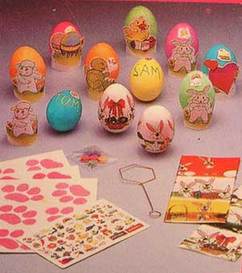As with almost all "Christian" holidays, Easter has been secularized and commercialized. The dichotomous nature of Easter and its symbols, however, is not necessarily a modern fabrication.
和其它基督教節日一樣,復活節正慢慢“被世俗”和“被商業”。即便如此,復活節的這兩個性質和它的標志并不是必然的“現代產物”。
The history of Easter 復活節的歷史
Since its conception as a holy celebration in the second century, Easter has had its non-religious side. In fact, Easter was originally a pagan festival.
“復活節是神圣的慶典”的概念在公元200年已經形成,自那時起,復活節就站在了非宗教的一方。而事實上,最初的復活節是異教徒的節日。
The ancient Saxons celebrated the return of spring with an uproarious festival commemorating their goddess of offspring and of springtime, Eastre. When the second-century Christian missionaries encountered the tribes of the north with their pagan celebrations, they attempted to convert them to Christianity. They did so, however, in a clandestine manner.
古撒克遜人慶祝春至時非常熱鬧,因為這也紀念他們祖先和春天的“復活”。在公元200年,基督教的傳教士并偶然來到這個擁有異教慶典的北方部落。這些傳教士嘗試讓撒克遜人改信基督教,而他們使用的方法非常隱秘。
It would have been suicide for the very early Christian converts to celebrate their holy days with observances that did not coincide with celebrations that already existed. To save lives, the missionaries cleverly decided to spread their religious message slowly throughout the populations by allowing them to continue to celebrate pagan feasts, but to do so in a Christian manner.
早期的基督教人為了慶祝他們神圣的節日而在儀式中自殺,然而這些儀式并沒有與以前的慶祝儀式相類似。為了拯救生命,傳教士略施小計,在人群中慢慢散布神明的信息,謊稱神明允許人們繼續慶祝異教節日,但是要使用基督教的方式進行慶祝。
As it happened, the pagan festival of Eastre occurred at the same time of year as the Christian observance of the Resurrection of Christ. It made sense, therefore, to alter the festival itself, to make it a Christian celebration as converts were slowly won over. The early name, Eastre, was eventually changed to its modern spelling, Easter.
就這樣,復活節在同年出現了,而且被當作耶穌復活的基督教儀式。因此,這個節日就慢慢被改變,漸漸轉變為基督教的一個節日。于是,人們漸漸皈依基督教。而復活節早期的名字Eastre,最后也被改成流傳至今的拼法Easter。

The date of Easter 復活節的日期
Prior to A.D. 325, Easter was variously celebrated on different days of the week, including Friday, Saturday, and Sunday. In that year, the Council of Nicaea was convened by emperor Constantine. It issued the Easter Rule which states that Easter shall be celebrated on the first Sunday that occurs after the first full moon on or after the vernal equinox. However, a caveat must be introduced here. The "full moon" in the rule is the ecclesiastical full moon, which is defined as the fourteenth day of a tabular lunation, where day 1 corresponds to the ecclesiastical New Moon. It does not always occur on the same date as the astronomical full moon. The ecclesiastical "vernal equinox" is always on March 21. Therefore, Easter must be celebrated on a Sunday between the dates of March 22 and April 25.
在公元325年之前,復活節的慶祝時間可以是一周中不同的時間,而這些時間包括星期五、星期六和星期天。在那些年里,康斯坦丁大帝組建了尼西亞理事會。這個理事會制定了復活節的標準:復活節應該在第一個滿月后或是春分后的第一個星期進行慶祝。在這里,我們要作一下解釋。在規定中所指的“滿月”是基督教的滿月,而“滿月”的時間定在陰歷月份的第十四天,那么,這個月的1號就是基督教的“新月”。由于天文滿月,復活節的日期不會是每年的同一天。另外,基督教的“春分”通常是3月21日。因此,復活節必須在3月22日-4月24日之間的其中一個星期天進行慶祝。
The Lenten season 四旬齋季節
Lent is the forty-six day period just prior to Easter Sunday. It begins on Ash Wednesday. Mardi Gras (French for "Fat Tuesday") is a celebration, sometimes called "Carnival," practiced around the world, on the Tuesday prior to Ash Wednesday. It was designed as a way to "get it all out" before the sacrifices of Lent began. New Orleans is the focal point of Mardi Gras celebrations in the U.S. Read about the religious meanings of the Lenten Season.
四旬齋是早期復活節里面為期46天的時期。四旬齋開始于圣灰星期三。“狂歡節”也稱為“嘉年華”。在早期,它橫跨星期三和圣灰星期四,是一個全世界都進行的慶典。在四旬齋獻祭開始前,狂歡節是一個使人身心舒暢的節日。其中,新奧爾良是美國狂歡節的焦點。因此,我們要好好理解四旬齋的宗教含義。
The Easter Bunny 復活兔
The Easter Bunny is not a modern invention. The symbol originated with the pagan festival of Eastre. The goddess, Eastre, was worshipped by the Anglo-Saxons through her earthly symbol, the rabbit.
復活兔并不是現代產物。復活兔起源于異教的復活節。當時,耶穌的世俗象征是一個兔子,并被盎格魯撒克遜人供奉著。
The Germans brought the symbol of the Easter rabbit to America. It was widely ignored by other Christians until shortly after the Civil War. In fact, Easter itself was not widely celebrated in America until after that time.
而德國人將復活兔帶到了美國。直至美國南北戰爭后,復活兔才被大多數基督教人士所重視。事實上,在這次內戰結束后,復活節也未在美國被人們廣泛地慶祝。

The Easter Egg 復活蛋
As with the Easter Bunny and the holiday itself, the Easter Egg predates the Christian holiday of Easter. The exchange of eggs in the springtime is a custom that was centuries old when Easter was first celebrated by Christians.
與復活兔和復活節一樣,復活蛋預示著復活節即將到來。當基督教徒慶祝第一個復活節后,人們開始春天互相交換復活蛋,而這已成為了人們好幾百年的習俗。
From the earliest times, the egg was a symbol of rebirth in most cultures. Eggs were often wrapped in gold leaf or, if you were a peasant, colored brightly by boiling them with the leaves or petals of certain flowers.
在早期,復活蛋在許多文明中象征著“再生”。人們常常用金色的葉子包裹復活蛋,或是農民的做法:將復活蛋畫得色彩斑斕,并把它和葉子或是真花瓣一起煮沸。
Today, children hunt colored eggs and place them in Easter baskets along with the modern version of real Easter eggs -- those made of plastic or chocolate candy.
在今天,孩子們到處搜刮復活蛋,并將這些蛋放到復活節籃子中。為什么呢?因為現代的復活蛋是用軟糖或巧克力做的。
相關閱讀
Same Easter, different celebrations
(來源:新浪教育 編輯:Julie)